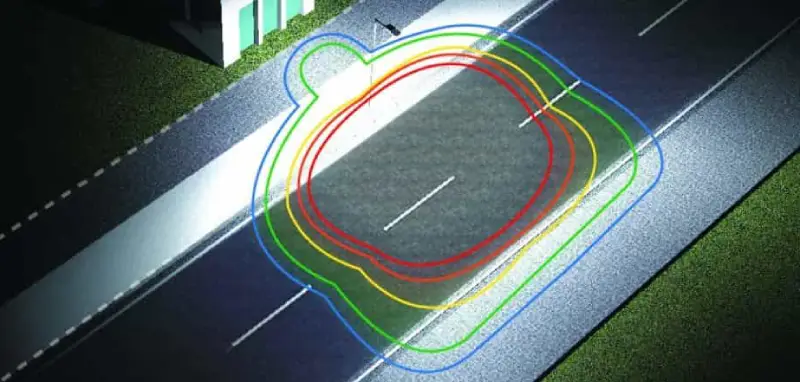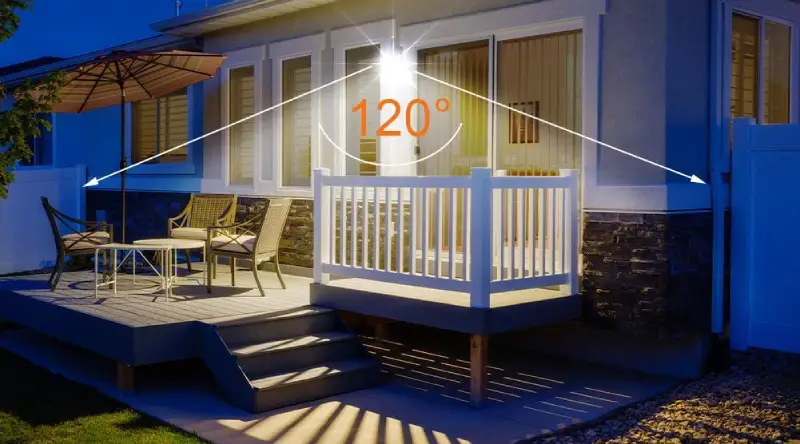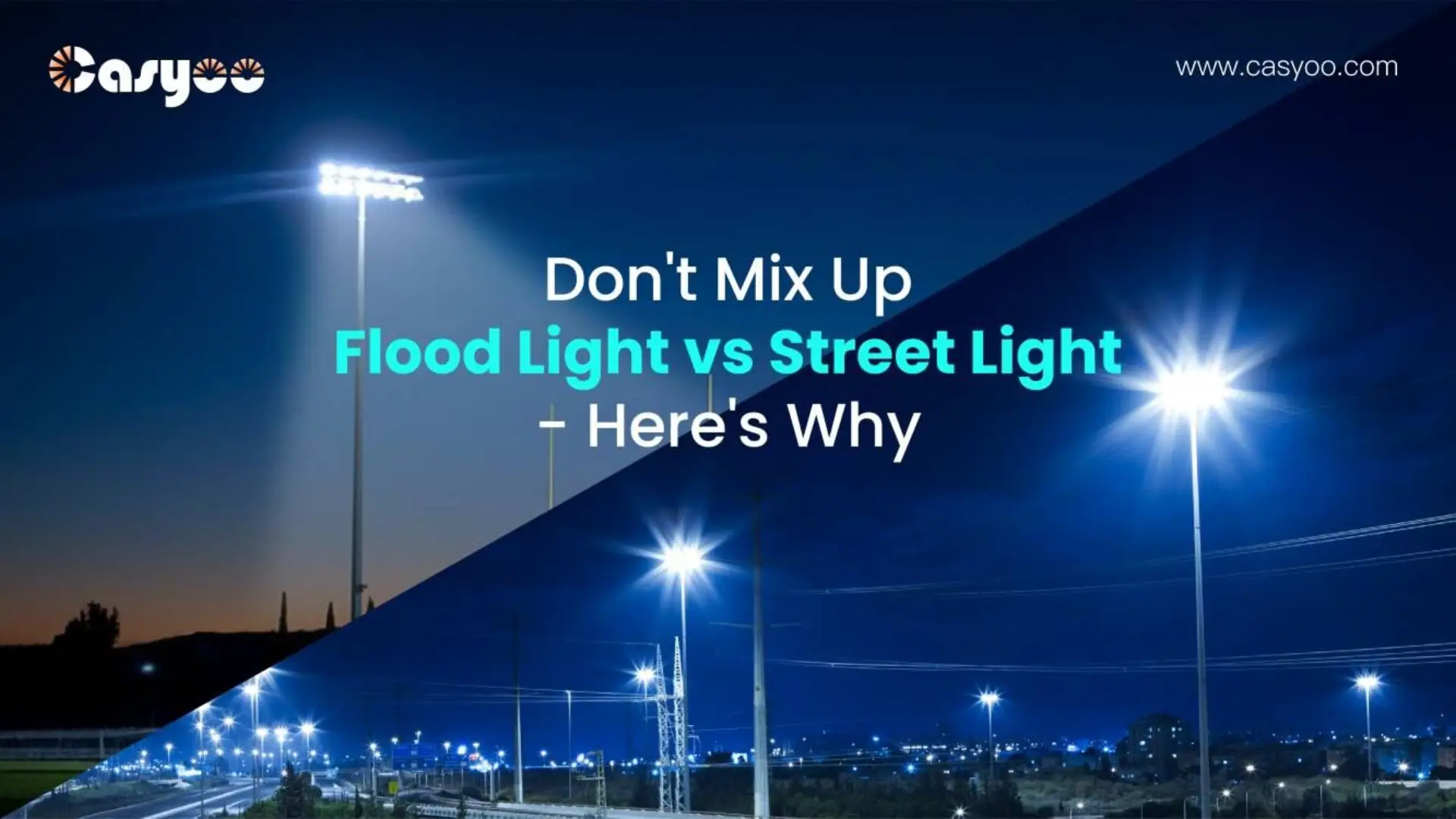Last week, a client asked me a seemingly easy question: “Can I simply use flood lights instead of street lights for my neighborhood project?” “They’re cheaper.” Flood light vs street light? After seven years as an LED lighting engineer, I’ve heard this question numerous times. The solution isn’t as simple as you would think, and selecting the wrong option could cost you a lot more in the long run.
Consider flood lights and street lights to be the equivalent of a shower head and a garden hose nozzle. Both deliver water, yet they serve quite different purposes. Street lights function similarly to garden hose nozzles, directing light to specific areas of the road. Flood lights, on the other hand, function like shower heads, distributing light across a larger area.
Let me walk you through the important differences and help you make the best decision for your project. Understanding these nuances can save you thousands of dollars and innumerable problems when installing a parking lot or upgrading your street lights.
Core Differences: More Than Just Light Distribution
The difference between flood light and street light becomes apparent in how these lights spread their output. The flood light beam angle vs street light comparison shows street lights typically have a fine optical control, ensuring that light is directed exactly where it is needed on the road surface. Flood lights, on the other hand, have a significantly wider beam (typically 120 degrees or more), which allows them to illuminate large regions with less directional control.
During a recent stadium lighting installation, we observed that employing street lights would have resulted in dark areas between poles, whereas flood lights provided the even coverage required for sports events. However, when the same client attempted to use flood lights for their parking lot access roads, the considerable light dispersal caused unpleasant glare for vehicles.


Technical Specifications That Matter
Understanding the LED flood light vs street light technical distinctions can have a big impact on your project’s success. Let me break down the most important specifications for real-world applications.
Flood Light vs Street Light: Lumens, Wattage, and Efficiency Compared
Modern LED streetlights have become incredibly efficient. A standard 150W street light currently provides approximately 20,000 lumens, effectively lighting up to 200 feet of highway. Flood lights, with their greater coverage, may require 200-300W to properly illuminate a same area, although their distribution is more consistent over open spaces. Therefore, for different outside spaces, you need to consider whether to use flood lights or street lights.
The energy efficiency of street lights vs flood lights becomes clear when comparing industry standards: LED street lights typically attain 140-150 lumens per watt efficiency ratings, which are maximized by their focussed beam patterns. Flood lights typically produce 120-130 lumens per watt due to their greater light distribution requirements. These disparities in efficiency have a direct impact on long-term operating expenses and energy consumption.
Expectations for lifespans have changed dramatically in recent years. Nowadays, high-quality LED street lights often reach 100,000+ hours of operation with less than 10% light deterioration. Flood lights, which are frequently exposed to a wider range of climatic conditions, usually provide between 50,000 and 80,000 hours. These performance indicators under real-world settings are validated by field data from long-term deployments.
Color Properties and Light Quality
A lighting project’s choice of color temperature can make or destroy it. The 4000K to 5000K range is usually where street lights run, giving drivers excellent vision that makes it easier to read signs and discern things. Applications for flood lights typically require a wider range (2700K–6500K) to meet a variety of requirements, such as security installations and architectural illumination.
Most people don’t realize how important color rendering skills (CRI) are. For traffic safety, street lights must have a CRI of 70+. Flood lights frequently have CRIs of 80+ or even 90+ for uses such as architectural highlights or shop displays. The accuracy with which colors appear in each form of lighting makes the distinction clear.
Smart Control Integration
Simple on/off switches are no longer the only feature of modern lighting systems. Modern street lights use advanced control systems that automatically modify brightness according to the time of day, traffic patterns, and weather. Compared to conventional timing systems, these clever characteristics usually result in a 25–40% reduction in energy consumption.
Floodlights’ sophisticated control features match this level of sophistication. Modern systems allow for exact control over timing, brightness, and even color temperature, and they integrate seamlessly with building management systems. While computerized scheduling guarantees ideal lighting for events and everyday operations, motion sensors can activate enhanced illumination in security applications.
The flexibility of these smart controls to adjust to particular requirements while preserving energy efficiency is where their true value lies. These features are especially helpful for large installations because they allow for zone-specific control and thorough usage monitoring.
Installation Considerations: Height, Position, and Cost
Installing street lights usually costs more up front and needs careful planning. To ensure proper coverage, industry standards need precise installation heights (typically 20-40 feet) and particular intervals. While flood lights have more mounting possibilities, they must be aimed accurately to avoid glare and light pollution.
The early expenditures may surprise you. Though flood light fixtures are less expensive ($100-125 versus $150-200 for street lights), the installation expenses for poles and wiring may be much higher if you choose the wrong application. I’ve worked on projects where the incorrect fixture type resulted in reinstallation expenses that were over $10,000.
Primary Applications: Versatility vs Specialization
Both floodlights and street lights perform exceptionally well in their designated settings. With their advanced optics that provide consistent lighting patterns essential for vehicle safety, street lights are specifically designed to illuminate roads. I worked on a highway project last month where our street lights’ unique light distribution design improved visibility and decreased accidents at a troublesome juncture.
The adaptability of flood lighting is quite impressive. Their versatility makes them useful in a wide range of applications, from illuminating sports grounds to showcasing architectural features. This adaptability was shown in a recent project at a multipurpose event center, where the same flood light fixtures were used to successfully illuminate both nighttime security patrols and outdoor festivities.
Combining the two types is advantageous for some applications. For instance, consider retail malls. While flood lights illuminate loading zones and building facades, street lights allow for safe passage through parking aisles. When directional control is required and extensive coverage is sought, this hybrid strategy frequently offers the best of both worlds.
When to Use Flood Lights vs Street Lights?
Commercial Applications
Combinations are frequently the most effective for parking lots. Generally speaking, we advise flood lights for open parking lots and street lights for driving lanes. This method minimizes the amount of fixtures required while offering the most visibility.
Industrial Settings
Flood lights are excellent at providing wide, uniform illumination for expansive indoor areas like manufacturing plants and warehouses. Consistent lighting throughout work areas is ensured by their wide beam angle, which is crucial for both productivity and safety.
Public Spaces
Proper street illumination is nearly entirely beneficial for streets and highways. For traffic safety, the specialized light distribution and focused beam pattern are crucial. However, additional flood lighting may be beneficial for nearby locations, such as parks or building facades.
Common Questions Answered
1. In the street light vs flood light debate, can flood lights replace street lights to save money?
Not advised. Inadequate illumination can result in safety hazards and increased long-term operating expenses, even though the original fixture cost may be lower.
2. How do I choose between flood lights and street lights?
Take into account three key elements: the area that requires illumination, the main objective (general illumination, safety, or aesthetics), and the available mounting alternatives.
3. What about maintenance costs?
Both kinds of high-quality LED fixtures should last for at least 50,000 hours, but because street lights are set in place, they usually need less modification over time.
4. how do flood lights differ from other lights in terms of coverage how much light they provide?
Flood lights with a power range of 50W–100W will illuminate areas from 50 to 150 square meters which suits residential driveways and small gardens. With power ratings exceeding 400W, they can cover 500 to 1000 square meters or more such as stadium complexes and industrial yards.
Making Your Final Decision
The floodlight vs street light decision between street lights and flood lights ultimately comes down to your individual requirements. Despite their greater starting costs, street lights are still the best option for illuminating roads and pathways. Flood lights are frequently the most economical option for wide open spaces that need consistent lighting.
Keep in mind that good lighting involves more than just brightness; it also involves efficiently directing light where it is most required. To make sure your decision fits your long-term goals and current requirements, think about speaking with a lighting expert.
Do you need assistance choosing the best lighting option for your project? Our staff of qualified lighting experts is prepared to offer a free consultation and comprehensive proposal based on your unique needs.




